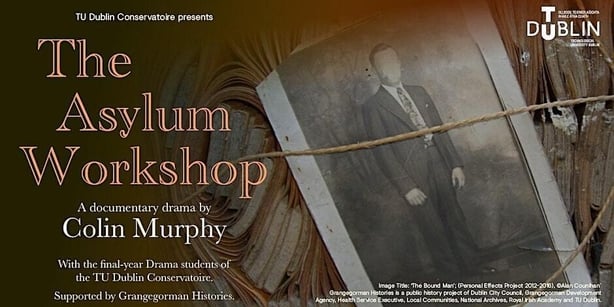Playwright Colin Murphy introduces his new documentary drama The Asylum Workshop, an 'investigation' of the history of the institution once known as the Richmond Lunatic Asylum in Dublin's Grangegorman area, which comes to TU Dublin (a stone's thrown from the original site) this June - talks to RTÉ Arena above.
For decades - centuries, even - Grangegorman was defined by walls. The psychiatric hospital there, known to most who passed through it as "the Gorman", and originally known as the Richmond Lunatic Asylum, was walled off from the surrounding city. What happened behind those walls was, to most, a mystery - unknowable, eerie, frightening.
Change started in the 1970s, as the psychiatrist Ivor Browne started to - literally - knock down the walls, and the model of psychiatric care began to shift towards a new focus on care in the community. At the turn of the century, there were still patients in the Gorman but, by 2013 - almost 200 years after it had opened - the last patients had finally moved to a new, smaller-scale, purpose-built facility (where, reportedly, their need for medication fell by half, such was the impact of their improved environment). Work was by then underway on a new masterplan for Grangegorman, to turn it into a campus for the new Technological University Dublin.
We need your consent to load this rte-player contentWe use rte-player to manage extra content that can set cookies on your device and collect data about your activity. Please review their details and accept them to load the content.Manage Preferences
Listen: The stars of The Asylum Workshop talk to Ryan Tubridy
But even as work proceeded apace on salvaging and repurposing the built heritage of Grangegorman, such as the original 1814 asylum building, one part of its heritage was, for a time, forgotten. The hospital had left behind a voluminous archive - from patient files to inspectors' reports to the hospital farm's annual returns - but no one had thought what to do with it. As well as files, there was a trove of artefacts - the patients' personal belongings, taken from them on admission. The hospital's former chaplain, Fr Piaras Ó Dúill, led a volunteer effort to save these, and the artist Alan Counihan produced an exhibition and an RTÉ radio documentary inspired by them. Eventually, the hospital's archive was entrusted to the National Archives. Last year, I was asked by the TU Dublin Conservatoire to go into the archives and write a play based on them for the Conservatoire's graduating drama students.
We need your consent to load this rte-player contentWe use rte-player to manage extra content that can set cookies on your device and collect data about your activity. Please review their details and accept them to load the content.Manage Preferences
Listen: Documentary On One: Ghosts Of Grangegorman
It took me a day to work out even where to find anything: most records I initially requested were bureaucratic and unenlightening. And then I found the Female Case Book, 1908: an immense, leather-bound volume with a new page for every new admission, page upon page of carefully-handwritten case notes, and perfectly-preserved studio portraits of each of the women admitted that year. Some of these women's stories had happy endings (in so far as we know): after a brief stay in the hospital, they were discharged, apparently cured. But others seemed to dissolve into the fabric of the institution, only to leave it upon death. I traced their notes through the case book: for the first year, there would be notes daily, then weekly, then monthly. Then the notes would become six-monthly, and these reviews would become increasingly cursory. One patient, CK, a 28-year-old mother of a toddler and an infant, was admitted suffering from delusions apparently triggered by "prolonged lactation". She never left. Thirty years later, she was merely "a demented and incoherent patient", apparently unvisited.
What happened behind those walls was, to most, a mystery - unknowable, eerie, frightening.
I brought transcripts of the records to the students I was writing for, and they workshopped them with the director, Peter McDermott. We debated the ethics of the project: what was our responsibility to these records, and to the people behind them? How close could a 20-year-old actor today hope to come to the life of someone suffering from mental ill-health a hundred years ago? Amidst all these hospital records, kept by doctors, nurses and administrators, where was the patient's voice? How well have other portrayals of "madness" in drama - from Ophelia in Hamlet to One Flew Over the Cuckoo's Nest - aged, and what could we learn from them?

And so, a play took shape: The Asylum Workshop, an investigation of the history of the institution once known as the Richmond Lunatic Asylum, by the students of the institution that stands in its stead today. It was staged as part of their course for a few nights last December; the reaction was such that the university decided to give it a proper, professional run, now that those same students are just emerging as professionally-trained actors. It's just one more step in the gradual dismantling of those walls.
The Asylum Workshop is at the Black Box Theatre, East Quad, TU Dublin Grangegorman campus, from June 14-24 - find out more here.

